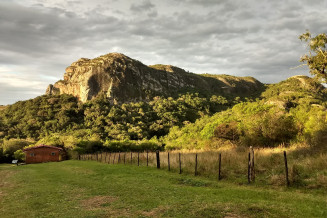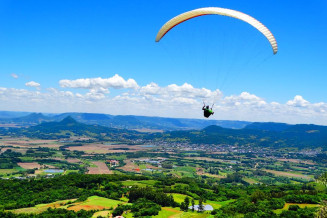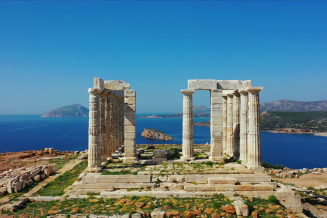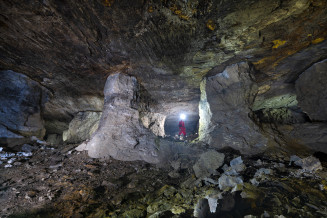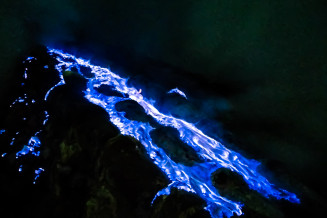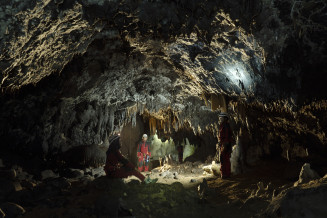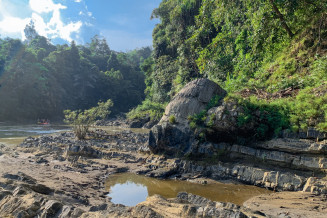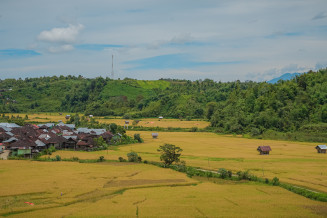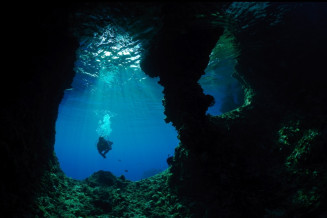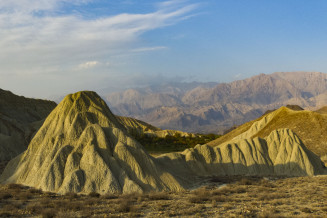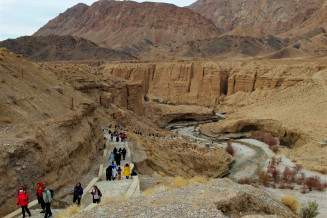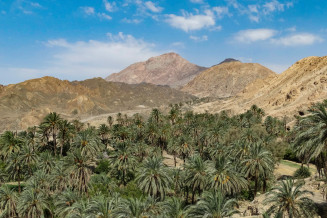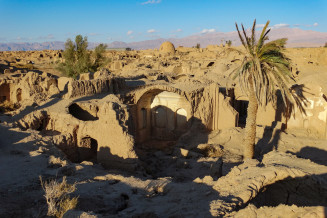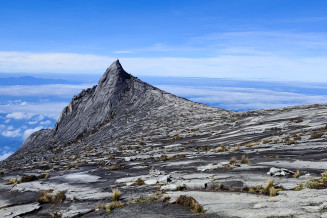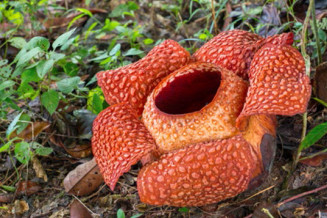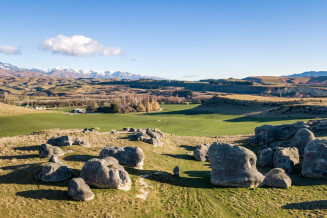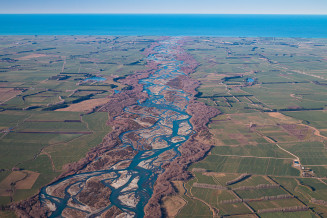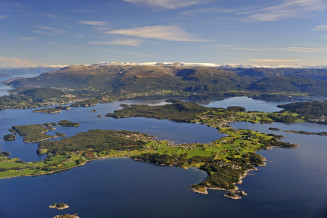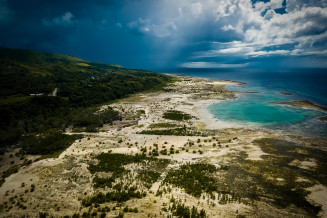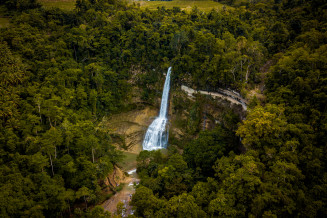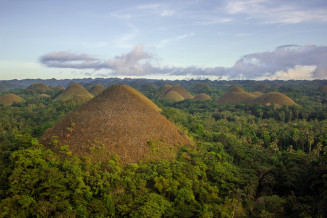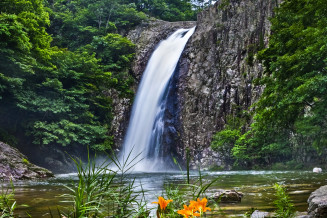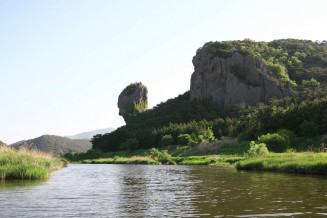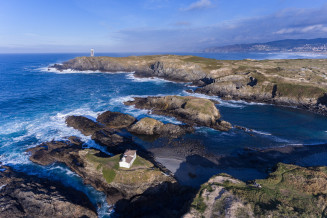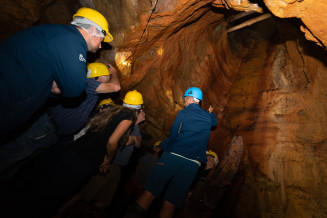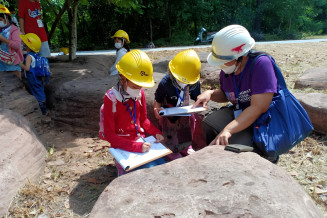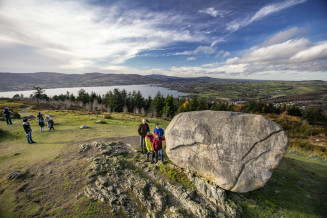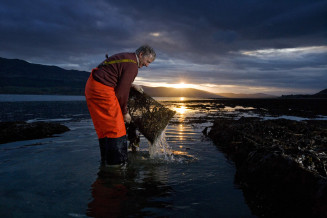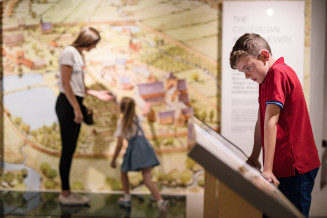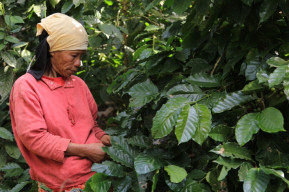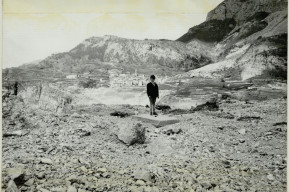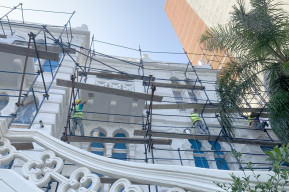Press release
UNESCO names 18 new Global Geoparks

The UNESCO Global Geopark label was created in 2015. It recognizes geological heritage of international significance. Geoparks serve local communities by combining the conservation of their significant geological heritage with public outreach and a sustainable approach to development. The 18 new designations have brought the network up to 195 UNESCO Global Geoparks, covering a total surface area of 486,709 km2, equivalent to twice the size of the United Kingdom.
The new geoparks are:
Brazil: Caçapava UNESCO Global Geopark
For the Guarani, an indigenous people in Brazil, this geopark is ‘the place where the jungle ends’. The geopark is located in Rio Grande do Sul State in southernmost Brazil. Its geological heritage, which consists of mining sulfide metals and marble, has been vital for the region’s economic development. The sedimentary deposits of volcanic origin in the Camaquã basin represent the most complete and well-exposed record of the transition of the South American Platform from the Ediacaran period to the Cambrian period between 600 and 500 million years ago. Ediacarans were the earliest known animals. These soft-bodied marine organisms were similar to modern-day species such as jellyfish. Besides its geodiversity, the geopark is home to endangered cacti, bromeliads, endemic flowers and bee species. The native shrublands and grasslands that surround the bare rock hills preserve a sustainable livelihood, that of family-based sheep and goat breeding. The geopark’s scenic hills served as natural military fortifications from the medieval to early–modern period.
Brazil: Quarta Colônia UNESCO Global Geopark
This geopark is located in the south of Brazil between the Pampa and Atlantic Forest biomes. Its name is a reference to the period when Italians colonised the central part of the state of Rio Grande do Sul. Thousands of European settlers placed their hopes and dreams in this “promising land” which borders a dense subtropical forest and lies between the deep fault valleys carved by a broad drainage network on the slope of the Serra Geral mountain range. There are colonial villas and traces of indigenous settlements of the quilombolas (Afro-descendants)which date back hundreds of years. The geopark is also rich in fossils of animal and plant life dated to 230 million years ago. It holds the record for the oldest dinosaurs on the planet, with Triassic fossils of great international significance.
Greece: Lavreotiki UNESCO Global Geopark
Famous for the abundance and variety of its mineralogical specimens, many of which were first discovered in the area, this geopark is known around the world for the silver that is extracted from mixed sulfide deposits. The region has been inhabited since antiquity due to its underground geological wealth, and is currently home to 25,102 inhabitants. Lavreotiki UNESCO Global Geopark also houses the Byzantine Holy Monastery of St Paul the Apostle. The monastery continues to promote ‘Orthodox monasticism’ and practice fresco mural painting, a traditional technique which uses natural colours ground from rock.
Indonesia: Ijen UNESCO Global Geopark
This geopark is located in the Banyuwangi and Bondowoso Regencies in East Java Province. The geopark’s strategic location between the strait and the sea has made it a crossroads for human migration and commerce. Ijen is one of the most active volcanoes in the Ijen caldera system. About 22 post-caldera volcanic cones have formed both inside the caldera and on its rim. Ijen is the most acidic crater lake on Earth and the largest of its kind. Thanks to a rare phenomenon, high concentrations of sulphur rise from the active crater before igniting as they encounter the oxygen-rich atmosphere; as the gas burns, it forms an electric blue flame which is unique and only visible at night. The water itself is acidic because it is recycled by seeping into the volcanic subsurface.
Indonesia: Maros Pangkep UNESCO Global Geopark
This geopark is located along the southern arm of the island of Sulawesi in the Maros and Pangkep Regencies. The local population is primarily composed of the indigenous peoples of Bugis and Makassarese. Although the geopark covers an area of 5,077 km2, more than half (55.4%) of it lies underwater. Separate from the mainland, the geopark area contains a cluster of 39 islands. This archipelago lies in the Coral Triangle and serves as a centre for the conservation of coral reef ecosystems. The geopark is known both for its Spectacular Karst Towers and for the Coral Reef Islands of Spermonde. The area covered by the geopark is more than 100 million years old; it bears traces of ancient life forms and is home to endemic species such as the black macaque and kuskus bear that live along the Wallace line (named after Alfred Russel Wallace, who came to similar conclusions about evolution as his contemporary, Charles Darwin), the deep sea trench separating the island of Borneo from the island of Sulawesi. The land to the west lies on the Asian continental tectonic plate, whereas the land to the east lies on the Australian continental plate; this accounts for the diversity of species found on these neighbouring islands.
Indonesia: Merangin Jambi UNESCO Global Geopark
This geopark is home to the unique fossils of “Jambi flora”, which are the only exposed fossilized plants of their kind in the world today. These are located in the central part of Sumatra Island in Indonesia. The name ‘Jambi flora’ refers to fossilized plants found as part of a rock formation dating from the Early Permian (296 million years old). These fossilized plants include mosses, primitive conifers and seed ferns, which reproduce via seed dispersal instead of through spores. The landscape of this geopark combines lowlands on the east side with highlands on the west side, with the highest peak rising to an altitude of 2,900 m above sea level on Mount Masurai, which was formed by a large eruption 33,000 years ago. The area has been inhabited since the prehistoric era and is home to different indigenous groups, including the Orang Batin Lamo tribe and the Serampas clan. The geopark is home to a karst landscape which formed during the Mesozoic era (252–66 million years ago). The karst caves contain prehistoric artefacts that are part of an important archaeological research project.
Indonesia: Raja Ampat UNESCO Global Geopark
This geopark’s territory includes four main islands and is special for having the oldest exposed rock unit in the country (Silurian–Devonian dating back 443.8–358.9 million years ago), which is almost one-tenth of the age of the Earth. The most unusual geological feature are the Tropical Islands which emerged as a consequence of sea-level rise in the Quaternary Period (between 2.58 million years ago and 11,700 years ago); here, karstification has created numerous caves both above and below the water line. Karst is made of limestone, which is a soft and porous rock that dissolves in water. As rainwater seeped into the rock over time, this rock slowly eroded, creating these caves. Scuba-divers flock to the area, drawn by the beauty of the underwater caves and the extraordinary marine mega-biodiversity. Here, they can observe rock art produced by prehistoric humans who lived in the area several thousand years ago.
Iran: Aras UNESCO Global Geopark
The Aras River marks the northern limit of this geopark located in northwestern Iran at the southern end of the Lesser Caucasus mountain range. This mountain range acts as a natural barrier. It has created a range of climates, as well as rich geodiversity and biodiversity; it also links different cultures on the northern and southern sides of the mountain chain. The most important geological feature of international significance in this geopark are the traces of the extinction event that occurred 252 million years ago which marks the Permian–Triassic Boundary, one of the most important events in the Earth's history. The geopark is also home to endangered animals such as the Caucasian Black Grouse, Red Deer, Armenian Ram and Caucasian Leopard, which inhabit three protected areas.
Iran: Tabas UNESCO Global Geopark
Many thinkers have referred to the 22,771 km2 of desert in northwest South Khorasan Province where this geopark is located as ‘the geological paradise of Iran’. This is due to the fact that one can follow the evolution of the planet from the earliest part of the Earth’s history 4.6 billion years ago (the Precambrian) to the Early Cretaceous about 145 million years ago without the slightest interruption. The geopark is home to Naybandan Wildlife Refuge, the largest in Iran, which covers an area of 1.5 million hectares and is the most important habitat of the Asian cheetah. Tabas UNESCO Global Geopark provides half of the global habitat of the endemic plant Ferula assa-foetida, which is widely used for medicinal purposes. Throughout history, the area has served as a highway linking the south and west to east and northeast Iran. Consequently, it attracts ecotourists for both its valuable natural and cultural heritage.
Japan: Hakusan Tedorigawa UNESCO Global Geopark
Located in central Japan, where it follows the Tedori River from Mount Hakusan down to the sea, the Hakusan Tedorigawa Geopark records approximately 300 million years of history. It contains rocks that were formed by the collision of continents. It also has strata containing fossils of dinosaurs which accumulated in rivers and lakes on land at a time when Japan was attached to the Eurasian continent. Volcanic deposits formed during the rifting process which separated Japan from the Eurasian continent about 15 million years ago, as the subducting plates pulled Japan eastward. More recent volcanic deposits date from the eruption of the still-active Mount Hakusan, one of Japan’s ‘Three Holy Mountains’. Rising 2,702 m above sea level, it records some of the highest levels of snowfall in the world for a mountain so close to the Equator. This heavy snowfall drives a water and erosion cycle that is continuously shaping the landscape.
Malaysia: Kinabalu UNESCO Global Geopark
Mount Kinabalu dominates this geopark in the State of Sabah at the northern end of the island of Borneo. The highest mountain lying between the Himalayas and New Guinea, Mount Kinabalu has been attracting explorers for over a century. Covering an area of 4,750 km2, the geopark is home to many endemic plants and animals, including 90 orchid species that exist only on Mount Kinabalu, and the crimson-headed partridge bird not found anywhere else on Earth. The geopark features incredible geodiversity, including ultramafic rocks which are billions of years old; Ultramafic rocks make up the Earth’s mantle but sometimes rise to the surface during a volcanic eruption. Granite intrusions are also visible on the surface: during a volcanic eruption, most magma never rises to the surface but, rather, remains hidden inside the crust where it solidifies into intrusive igneous rocks like granite. The geopark also features unique landforms that include the Poring Hot Springs and the Ranau-Tambunan area, which consists of folded and faulted sedimentary rocks.
New Zealand: Waitaki Whitestone UNESCO Global Geopark
New Zealand’s first UNESCO Global Geopark lies on the east coast of the South Island, extending over an area of 7,214 km2 from the Waitaki Valley to the base of the Southern Alps. The landscapes, rivers and tides of this geopark have enormous cultural significance for the local indigenous people, the Ngāi Tahu whānui. The geopark offers exceptional insights into the history of the Earth’s eighth continent, Zealandia, or Te Riu-a-Māui in Maori. The geopark provides evidence of the formation of Zealandia, which broke away from the ancient supercontinent of Gondwana around 80 million years ago. The continent then became submerged under the ocean for millions of years before tectonic forces thrust New Zealand above the waves and the country’s current mountain-building phase began. Today, about 94% of Zealandia remains submerged, stretching from east of New Zealand all the way north to New Caledonia.
Norway: Sunnhordland UNESCO Global Geopark
The landscapes in this geopark range from glacier-covered alpine mountains to archipelagos with thousands of islands situated on the strandflat along the coast. The geological landscape displays textbook examples of glacial erosion that occurred during 40 ice ages. The Hardangerfjord Fault separates a billion years of geological evolution. The geopark showcases how volcanic systems build continents: at the place where two tectonic plates converge, the compressed plate crumples before being uplifted to form a mountain range in a process known as orogeny. Two of the largest orogenic belts on Earth meet in the geopark. On the south side lie rocks related to a continental volcanic arc (1.5 billion years ago) and, on the north side, lies bedrock from the oceanic crust and an island arc system (500–450 million years ago).
Philippines: Bohol Island UNESCO Global Geopark
The Philippines’ first UNESCO Global Geopark, Bohol Island, sits in the Visayas island group. The island’s geological identity has been pieced together over 150 million years, as periods of tectonic turbulence have raised the island from the ocean depths. Traces of the island’s subterranean past can be found in the limestone which forms characteristic karstic structures. The geopark abounds in karstic geosites such as caves, sinkholes and cone karst, including the famous cone-shaped Chocolate Hills in the centre of the geopark. The Danajon Double Barrier Reef along the northern coast is the only one of its kind in Southeast Asia and one of just six documented double barrier reefs on Earth; it provides visitors with a chance to discover 6,000 years of coral growth. Danajon Double Barrier Reef consists of two sets of large offshore coral reefs which were formed by a combination of favourable tidal currents and coral growth on a submarine ridge in the area.
Republic of Korea: Jeonbuk West Coast UNESCO Global Geopark
This geopark tells 2.5 billion years of well-exposed geological history in the western part of the country. The vast tidal flats dotted with volcanoes and islands allow us to travel through time to piece together elements of the Earth’s history. The Korean word for tidal flats is ‘getbol’. The Gochang Getbol is one of 19 coastal wetland areas in the world with a tidal range greater than 5 m (macrotidal). Up to 40 m of mud sediment layers have been forming for 8,500 years, making this one of the thickest tidal sediment layers in the world, rich in sediments from the Holocene, which began 12,000–11,500 years ago. Jeonbuk West Coast UNESCO Global Geopark has already been recognized by UNESCO as a natural and cultural World Heritage property and as a biosphere reserve. It has also been designated a Ramsar site for its exceptional wetlands.
Spain: Cabo Ortegal UNESCO Global Geopark
Take a journey into the interior of our planet by discovering rocks that emerged from the depths of the Earth almost 400 million years ago in what is now Cabo Ortegal UNESCO Global Geopark. This geopark provides some of the most complete evidence in Europe of the collision that caused Pangea, a process known as the Variscan Orogeny. Most of the rocks in this geopark were brought to the surface by the collision of two continents, Laurussia and Gondwana, which would eventually join the supercontinent Pangaea about 350 million years ago. When this collision occurred, these rocks were situated in the Earth’s upper mantle, at a depth of more than 70 km. The copper exploited in the geopark’s mines originated from intense thermal activity on the seabed, where volcanic chimneys – called fumaroles – released gases and minerals at a high temperature which then cooled upon contact with water.
Thailand: Khorat UNESCO Global Geopark
This geopark is mostly located in the LamTakhong river basin on the southwestern margin of the Khorat Plateau in Nakhon Ratchasima Province in northeast Thailand. Deciduous dipterocarp forests are the dominant forest type in the area. The unique geological feature of the region is the diversity and abundance of fossils ranging in age from 16 million to 10 000 years. A large range of dinosaurs and other animal fossils like ancient elephants have been found in Mueang District. Petrified wood has also been discovered in sand and gravel deposits both in the Chaloem Phra Kiat and Mueang districts of Nakhon Ratchasima. This has prompted Khorat UNESCO Global Geopark to consider itself the Paleontopolis (City of Ancient Life) of the world. The unique culture of the area is called the Thai Khorat Cultura. Khorat is known for the Khorat language, people and music; Khorat has also been internationally recognized in the scientific names of new vertebrate fossil species discovered in the geopark, such as Khoratosuchus jintasakuli (a crocodile) and Sirindhorna khoratensis (a dinosaur).
United Kingdom of Great Britain and Northern Ireland: Mourne Gullion Strangford UNESCO Global Geopark
This geopark tells the tale of how two oceans evolved over 400 million years of geological history. It charts the closure of the Iapetus Ocean and the birth of the North Atlantic Ocean, which generated large amounts of molten rock (or magma) both within the Earth’s crust and on the surface. The subsequent rocks and landscapes have since been shaped by numerous Earth processes but dominated by those during the most recent Ice Age. The combination of mountain and coastal environments has led to the development of a hugely diverse range of glacial features not commonly seen in such a small area. These provide evidence of multiple stages of ice development and movement in the Mourne Mountains and in Strangford Lough. The geopark is located in the southeast of Northern Ireland, adjacent to the border with the Republic of Ireland, and covers an area of 1,932 km2. People have inhabited this area since just after the end of the last glaciation.
More information
Media resources
Media contacts

Phone: +33 1 45 68 22 93

Phone: +33145681729


